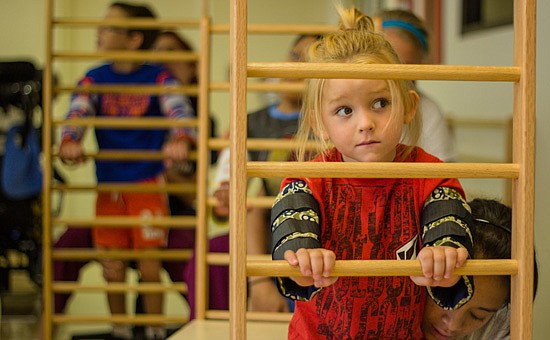- April 18, 2024
-
-
Loading

Loading

In a few weeks, many children who crawled or rolled their wheelchairs into summer camp at the Conductive Education Center of Orlando will walk out the door.
“I absolutely could see the change in them, the amount of progress was visible, tangible, I saw them walk out,” said Vicki Briley, education coordinator for CECO. She’s watched a history of success measured in footsteps.
Consider it a physical therapy facility on steroids. Instead of tiny increments of therapy, it’s an immersive process called conductive therapy. Children or even young adults may be pushed in, but once they’re inside CECO, therapists do another kind of pushing.
“Wheelchairs get left at the door,” said Joe Raymond, founder of CECO. “Everything is geared toward them having to get independent.”
Students come in with a range of needs and challenges, which include areas of gross and fine movement, cognition, social skills, emotional development and speech. The conductive education system works to address all of these issues, all at the same time. The system has a holistic approach to education, and treats the whole child. So because the child’s challenges can significantly affect motivation, confidence and personality, conductors — what the teachers are called — address that with lots of positive reinforcement.
The range of programs spans a generation of age groups and care intervals, designed around goals beyond the norm. They offer summer camp, before and after school programs, a program for young children 6 months to 4 years old, and a full-day school for students aged 5 to 21. But the difference is in the intensity and the mixing of therapies to work mind and body at the same time.
In a traditional therapeutic or public school situation, a child might get 30 minutes or an hour a couple times a week of individual therapies, such as physical therapy, occupational therapy or speech therapy.
“You can’t see growth that way,” Joe said.
For more information about conductive education and the Conductive Education Center of Florida, visit www.cecfl.org or call 407-671-4687.
What makes conductive education unique is that it offers teachings that are very similar and combine them all at once — for an entire school day at CECO. That continuity and consistency makes the students much more likely to master and maintain new abilities.
“It’s much more intensive,” said Briley, who has 25 years of teaching and administrative experience in special needs education. “From a teaching standpoint this is optimal practice.”
Vicky and Joe Raymond founded the school in 2001, after their son Joseph was born three months early with cerebral palsy. He weighed just a little more than 2 pounds, and both he and Vicky nearly lost their lives during birth.
“It was a blur,” Joe said. “I think they thought our son would never make it.”
Joseph, who is 17 now, endured 25 cranial surgeries during the first three years of his life. Doctors didn’t see standing, let alone walking, in his future. His life was full of “cant’s.” But he does walk, and swim, and bike. He wasn’t supposed to be able to eat without a feeding tube, and now he feeds himself. The Raymonds attribute his accomplishments to conductive education. When they saw the system in action, they knew they couldn’t keep it to themselves.
“We can’t just do this for our child,” Vicky thought. “They all deserve to learn.”
So they used Joe’s business background to build the nonprofit, and brought conductors to Winter Park from Hungary, where the system originated. There are a few of its kind in the U.S., but what makes CECO unique still is that they’ve integrated special and general education with conductive education. So, for example, a child will have to practice walking to an academic station while counting their steps, where they’ll do math by reaching for the blocks that solve the equations. They might also incorporate a breathing technique. This combines physical and speech teaching by the conductor — walking, reaching, counting and breathing — with the general education of math.
“There’s teaching in all movements,” said Andrea Berecz-Prewitt, lead conductor at the school.
Everything has a purpose and relates to real life. If the student needs to strengthen a particular muscle, there are no lifting weights; instead they do an everyday activity that builds those muscles.
CECO has helped many children like Joseph. Brandon’s parents came to camp hoping he would be able to maneuver his wheelchair; he left walking with a slider. Sophia’s parents kept hearing what she couldn’t do; CECO gave them possibilities. She came in crawling and now walks with canes and can read and write.
“Everybody is here because they believe these children can do what they’ve been told they couldn’t do,” said Rosene Johnson, executive director for CECO. “This program is literally watching faith in action.”
Their successes have led them to want to grow. CECO will be moving to a new building nearly three times the size of the current one next January, and Joe said he hopes to build onto that and have a whole campus for CECO students, a training center and curriculum to train conductors here in the U.S. and an adult program to maintain students’ skills. He guarantees they’ll be able to help those older than 22 when his own son reaches that age. Without Joseph, CECO wouldn’t be here.
“He’s the reason why,” Joe said.
A dozen years later, hundreds of other footsteps have followed Joseph out the door.